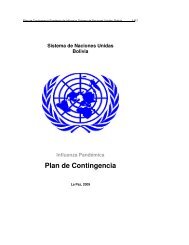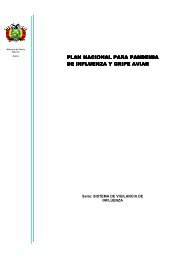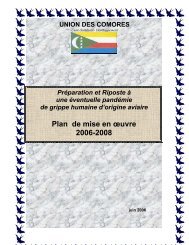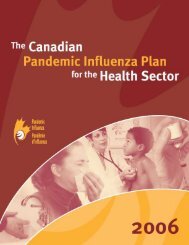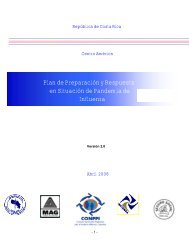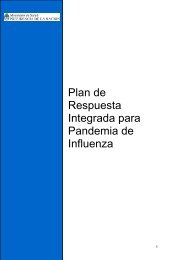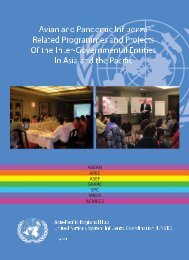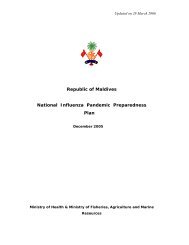Tanzania National Plan (January 2007)[1].pdf - Avian Influenza and ...
Tanzania National Plan (January 2007)[1].pdf - Avian Influenza and ...
Tanzania National Plan (January 2007)[1].pdf - Avian Influenza and ...
Create successful ePaper yourself
Turn your PDF publications into a flip-book with our unique Google optimized e-Paper software.
<strong>Tanzania</strong> <strong>Avian</strong> <strong>Influenza</strong> <strong>National</strong> Emergency Preparedness & Response <strong>Plan</strong><br />
Table 4. Cumulative Number of Confirmed Human Cases of <strong>Avian</strong> <strong>Influenza</strong><br />
A/(H5N1) Reported to WHO by 13 March 2006<br />
2003 2004 2005 2006 Total<br />
Country cases deaths Cases deaths cases deaths cases deaths cases deaths<br />
Cambodia 0 0 0 0 4 4 0 0 4 4<br />
China 0 0 0 0 8 5 7 5 15 10<br />
Indonesia 0 0 0 0 17 11 12 11 29 22<br />
Iraq 0 0 0 0 0 0 2 2 2 2<br />
Thail<strong>and</strong> 0 0 17 12 5 2 0 0 22 14<br />
Turkey 0 0 0 0 0 0 12 4 12 4<br />
Viet Nam 3 3 29 20 61 19 0 0 93 42<br />
Total 3 3 46 32 95 41 33 22 177 98<br />
2.6. Role of Ducks <strong>and</strong> geese<br />
Ducks <strong>and</strong> geese are susceptible to infection with all AI virus strains. AI virus is<br />
commonly isolated from these species in endemic areas, but only some very virulent<br />
viruses produce clinical disease.. These birds may therefore act as potential<br />
reservoirs for poultry <strong>and</strong> humans. Presently, the spreading AI subtype H5N1 is<br />
causing widespread deaths to these birds as it is doing to chickens wherever it has<br />
being detected.<br />
2.7. AI in other birds<br />
Guinea fowls, quails, pheasants <strong>and</strong> partridges are susceptible to infection <strong>and</strong> clinical<br />
disease. In quails infection appears to spread slowly AI has been associated with a<br />
syndrome characterized by respiratory signs, enteritis, weakness <strong>and</strong> death in<br />
ostriches. Mortality in young ostriches may be 30% or higher. An outbreak of HPAI<br />
due to a highly pathogenic H5N2 subtype virus occurred in ostriches in South Africa in<br />
2004. AI viruses have not been isolated from caged birds, including psittacines <strong>and</strong><br />
canaries.<br />
AI viruses are readily recovered from free-flying aquatic birds throughout the world. No<br />
significant disease problems due to AI are known to occur in these birds. Crows have<br />
become infected with <strong>and</strong> died from H5N1 subtype virus infection. Indian crows have<br />
a very significant presence along the coastal line especially Tanga, Dar-es-salaam<br />
<strong>and</strong> Zanzibar <strong>and</strong> in case of an AI outbreak would be one of the mechanical carriers to<br />
watch for in the containment <strong>and</strong> control of the disease.<br />
2.8 Role of pigs<br />
<strong>Tanzania</strong> has a pig population of 1.2 million. The husb<strong>and</strong>ry of these animals ranges<br />
from free ranging in rural areas to confinement in peri-urban settings. Pigs have<br />
special significance in the biology of <strong>Avian</strong> <strong>Influenza</strong>. They can be infected by H1N1,<br />
H3N2, <strong>and</strong> H1N2 that are also infectious to humans <strong>and</strong> H4N6 <strong>and</strong> H5N1 that are<br />
infectious to Birds. In this regard these animals are considered to be mixing vessels,<br />
which can facilitate development of new types of viruses.<br />
15


![Tanzania National Plan (January 2007)[1].pdf - Avian Influenza and ...](https://img.yumpu.com/36423433/15/500x640/tanzania-national-plan-january-20071pdf-avian-influenza-and-.jpg)
